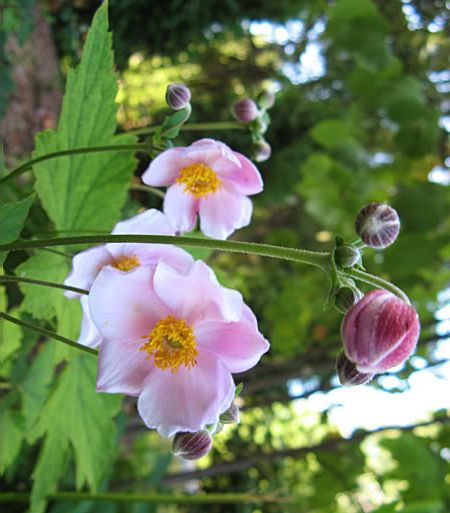Sunday, August 31, 2008
Sun Showers
Posted by Kylee Baumle 11 comments
Labels: blooms, green thumb sunday, tropicals
Saturday, August 30, 2008
Hanging On To Summer

The air is different. Nights are cooling, but even the summer breezes on the hottest days have a little less heat in them. The skies are beginning to turn that caerulean color that is only seen at this time of year. Yes, summer is waning, but it's not over until it's over.
Nancy J. Bond of Soliloquy says it best . . .
Treasure Your Garden
At August's end we hold our breath
And wait for Summer's certain death;
We spend our gardening time in dread
Composting favorite flower heads.
We dig and weed and mulch and till,
Hanging on to warm days still
Occurring, though they're shortened soon
By early dusks and golden moon.
We walk our garden paths with sighs
That summer goes so quickly by;
Cupping one persistent bloom
That helps dispel this August gloom.
"Pshaw!" say I, don't be so glum,
Look forward to the days to come!
Just think of all the kneeling, raking,
Bending, til your back is aching.
Of all the whirligigs and gnomes,
Gazing balls and Old Toad homes
That must be cleaned and put away,
Made ready for another day.
Of pools to empty, ponds to drain,
Gourds to pick before fall rains.
Hoes and spades and other tools
Must all be stored as weather cools.
But I, for one, embrace the days
Of clear, crisp air and morning haze,
Of walks though tunnels red and gold,
Of wisps of smoke as nights grow cold.
Of quilts and books beside the fire,
Pumpkin pies and apple cider.
And soon enough, a crystal frost
When heat of Summer's truly lost.
Though I'll be glad for cooler air,
I'll bide my time til it is here;
We mustn't wish away our days,
But fill them in delightful ways.
So, for today, my garden blooms!
Although it might be over soon,
These days of August still bring pleasure.
Embrace your fading garden treasures!
- (c) 2008 Nancy J. Bond

Nancy's blog is one of my favorite places to visit. She's a master at creating words to go along with beautiful photographs of her gardens (and other things).
She's located in Nova Scotia, Canada, a place I hope to one day visit, as my parents will be doing in October. I have her gracious permission to reproduce her poem here.
Thank you, Nancy.
Posted by Kylee Baumle 2 comments
Déjà Vu
What can I say? It's last summer all over again. We've had no rain for oh, let's see . . . six weeks. And then it was .2 of an inch. The time before that was July 8, when we got almost an inch. Things are drier than dry.  We planted a tree at the beginning of the month and as far down as we dug, it was bone dry. There are huge cracks in the yard and the gardens, in spite of the watering we've been doing. We don't water the yard at all and it's crunchy brown, having gone dormant.
We planted a tree at the beginning of the month and as far down as we dug, it was bone dry. There are huge cracks in the yard and the gardens, in spite of the watering we've been doing. We don't water the yard at all and it's crunchy brown, having gone dormant.
Didn't we do this last year?
The next chance for rain is September 5th and even then it's calling for isolated thunderstorms. The plants and trees are showing signs of stress and we're doing our best to keep them minimally happy until we get a good soaking rain. I hate to see things go into winter in this compromised condition. It won't bode well for them to survive the harsh winter that we're predicted to have.
So I repeat: Is it too much to ask for a LITTLE PRECIPITATION???
Posted by Kylee Baumle 11 comments
Friday, August 29, 2008
The Skinny Scaredy-Cat
Buffy has warmed up to us quite nicely and while some of the other cats aren't quite sure whether he belongs here, they'll get over it. I mentioned that there had been another stray hanging around looking for food - a skinny, skittish black one - and that we hadn't seen it in a few days.
He/She was back today. I looked out the kitchen window and there it was, lounging under the Japanese Maple. I tapped on the window and it looked at me, but remained at rest. Buffy came to check it out, decided it wasn't worth much of his time and moved on.
It doesn't look all that skinny in this picture because cats sleep fat, you know, but take my word for it. There isn't much meat on those bones. The fur around its neck is coming out in clumps now, which may be due to some run-ins with some of the other cats, or maybe it's due to a health issue. In any case, its fate is still up in the air as long as it won't let us get close.
If people would just take care of their animals, we wouldn't have such things happening. While we have taken in needy cats for the last four years, we really only wanted one inside and one outside cat. Now we have nine altogether.
Maybe ten.
Posted by Kylee Baumle 6 comments
Labels: cats
The Cicada Killers Scare Me, Too!
I'm allergic to bee stings. Yet honeybees don't scare me, because they're usually not aggressive and I respect them. I even like them. I used to freak if one was buzzing close-by but now I don't give them a second thought.
Paper wasps, yellow jackets, and mud daubers get a whole lot more of my respect for their space, but I'm not too bothered by those, either. I try to watch my pop can if I've got it outside, just in case they want a sip, too. But when the Cicada Killers come to town, I'm outta here.
If you've never seen one of these ginormous wasps, good for you. They're big, bad, and ugly. I don't care if only the females sting and will only sting if you bother them. I'm not about to test that. These are not your everyday, run-of-the-mill wasps. You could probably catch one, deep-fry it, and feed a family of four with it.
Why are they called Cicada Killers? Because that's what they do. They kill the cicada, drag it into their nest in a hole in the ground, lay an egg in it, then seal it up. The larva then eats the rest of the cicada while developing into yet another one of these beasts, after spending the winter in a cocoon.
They emerge in late July and August, when their prey (Annual cicadas) are also present. They're considered beneficial pests, and I'll just have to trust that they are, but they still scare the bejeebers out of me.
____________
Photo by fairlane of Jonestown. What? You think I was going to get close enough to take a picture myself? Are you nuts?
Posted by Kylee Baumle 13 comments
Labels: insects
Thursday, August 28, 2008
Pulling Carrots Is a Lot Like Pulling Teeth
 I've been pulling the 'Parisian Market' round carrots for a few weeks now, so I thought I'd better check on the 'Bolero' Nantes ones. Sure enough, many of them were of sufficient size to warrant harvesting.
I've been pulling the 'Parisian Market' round carrots for a few weeks now, so I thought I'd better check on the 'Bolero' Nantes ones. Sure enough, many of them were of sufficient size to warrant harvesting.
As I've said before, it just about kills me to thin seedlings of anything and I just didn't do it with the carrots. Thinning is really essential for good carrot growth though, with them being a root crop. They need room for filling out and if they're all crowded closely together in a small space, especially with heavy clay soil, they won't reach their potential. Still, we had plenty of nicely-sized carrots.
Being a dental hygienist, as I was digging and pulling the carrots it struck me just how similar the process is to extracting teeth. Some of the same problems that occur with teeth also happen with carrots. 
Some teeth have bifurcated roots:
Some have trifurcated roots:
As you can imagine, teeth and carrots with roots like that are more difficult to remove. Sometimes when you tug at a carrot (tooth), it's so firmly entrenched in the ground (bone) that the top (crown) breaks off.
Then you have to use a shovel (elevator) to help lift it out. And sometimes, despite your best efforts, the carrot (root) breaks and you have to go down deeper to get to the broken part. 
When you have carrots that are in close proximity to each other, sometimes they grow any which way they can in any available space. That leads to the creation of very oddly shaped carrots.
Then there are those that for no obvious reason are just weird.

Fortunately, the majority of carrots grow just like they're supposed to - straight. Most carrots are of the long and tapered variety and just like teeth that have roots that are tapered, these are the easiest to pull. In the case of the carrots, that makes them much easier to clean, too.

How about that? Curious carrots and a lesson in dentistry all at the same time!
Posted by Kylee Baumle 7 comments
Labels: edibles, vegetables
Wednesday, August 27, 2008
The Monarch Buffet Is Now Serving
 It's Monarch caterpillar time at Our Little Acre. We grow four different Asclepias (Asclepias tuberosa, Asclepias tuberosa 'Hello Yellow', Asclepias curassavica, and Asclepias incarnata), and every single one has one or more Monarch caterpillars munching happily away.
It's Monarch caterpillar time at Our Little Acre. We grow four different Asclepias (Asclepias tuberosa, Asclepias tuberosa 'Hello Yellow', Asclepias curassavica, and Asclepias incarnata), and every single one has one or more Monarch caterpillars munching happily away.  This is the first year that we've grown Asclepias curassavica and I have to say it's my favorite of them all, because of the color combination of reddish-orange and golden yellow. It's the only annual of the bunch, and I'm happy to see that it's forming seed pods so I'll be able to collect seed and grow it next year as well.
This is the first year that we've grown Asclepias curassavica and I have to say it's my favorite of them all, because of the color combination of reddish-orange and golden yellow. It's the only annual of the bunch, and I'm happy to see that it's forming seed pods so I'll be able to collect seed and grow it next year as well.
Yesterday morning I took a head count of Monarch cats and there are 11 that I could see. Some were big and fat and no doubt will soon become chrysalides. Others are so tiny that you'd miss them in a blink. On Sunday, I was showing Kara how beautiful the blooms on the Asclepias curassavica were and by some miracle, I noticed two caterpillars in their second instar (out of five) nestled down in a cluster of blooms:
With a macro photo like that, it's hard to tell how big or little those caterpillars really are, so I'll tell you. One-quarter of an inch long and no bigger around than pencil lead. Their antennae aren't even fully formed yet! Now you see why it can be easy to miss them. And if that isn't amazing enough, these came from eggs that are no larger than this: · This year it seems that they prefer the Swamp Milkweed (Asclepias incarnata) plant that we relocated from the creek bank last summer. I counted six on that one plant. I'd like to go dig a couple more of those, both for the Monarchs and for me, as I think their blooms are really pretty and remind me of beaded jewelry. There's a white-blooming one called 'Ice Ballet' that I'd like to grow, too.
This year it seems that they prefer the Swamp Milkweed (Asclepias incarnata) plant that we relocated from the creek bank last summer. I counted six on that one plant. I'd like to go dig a couple more of those, both for the Monarchs and for me, as I think their blooms are really pretty and remind me of beaded jewelry. There's a white-blooming one called 'Ice Ballet' that I'd like to grow, too.
No doubt the butterflies that these caterpillars will eventually become will be the ones that make the trip to Mexico. Peak migration in our area occurs during the third week in September. There will be other Monarchs that will be emerging right up until that point and for a short time after, but it's unlikely that many will stay here and produce another generation before the time to leave arrives.
And that's one of the most fascinating miracles of miracles that are the Monarchs. Of the several generations that are born during their summers spent north, how does this last generation know that they are the ones that will carry on the species through the winter by making the long trip to Mexico? What is it genetically that allows them to live longer (8 or 9 months) than their spring and summer ancestors, who live just two to five weeks? Earlier, we saw big fat cats on the Asclepias and then they disappeared. They've transformed into chrysalides, but we've never been able to find any. It's not uncommon for them to crawl to a location thirty feet away from where they spent their days munching on the milkweeds, wherever they feel is a protected location.
Earlier, we saw big fat cats on the Asclepias and then they disappeared. They've transformed into chrysalides, but we've never been able to find any. It's not uncommon for them to crawl to a location thirty feet away from where they spent their days munching on the milkweeds, wherever they feel is a protected location.
Last evening, I found a smallish one crawling around on a daylily which was nowhere near any of the Asclepias plants. At first I thought it must be a Swallowtail cat, but it was definitely a Monarch. It appeared to be chewing on the edge of the leaf, which goes against what I've always been told - that Monarch caterpillars only feed on Asclepias. I carefully moved him to the Butterfly Weed (Asclepias tuberosa). This morning, he was eating the nearby Rue!
There's always one in the bunch, isn't there?
Posted by Kylee Baumle 14 comments
Labels: butterflies
Tuesday, August 26, 2008
I'm Just a Girl Who Can't Say No

And Romie is my male counterpart. That's convenient, isn't it? I mentioned that we'd had a couple of stray cats hanging out at Our Little Acre for the last month or so. Where do they come from? If only they could speak English, we'd know. Regardless, this is where so many end up, looking for something to eat, a safe place to sleep, and a little loving care.
 When the scared skinny black one and the buff-colored friendly one first showed up, Romie called them Blackie and Blondie. This clearly went against his own rule of not naming any strays until they let us pet them. But when two cats show up at the same time (coincidence?), you have to have a way to distinguish between them as you discuss their futures.
When the scared skinny black one and the buff-colored friendly one first showed up, Romie called them Blackie and Blondie. This clearly went against his own rule of not naming any strays until they let us pet them. But when two cats show up at the same time (coincidence?), you have to have a way to distinguish between them as you discuss their futures.Blackie is clearly the most fearful of the two. We haven't been able to get the least bit close to him, not even close enough to determine if he is indeed a 'him'. But Blondie has warmed up to us quite nicely and since he's a very definite 'him,' I nixed the Blondie moniker. We tossed around a few names, and settled on Buffy. I know that's a girl's name, too, but I like it better than Blondie and Buffy Cat won't know the difference anyway.
I haven't seen Blackie for a couple of days, but I'm sure we'll see him again soon.

Meanwhile, Buffy has very definitely adopted us, so we'll be taking him in to be neutered and immunized soon. He follows me all around the garden, much to Max's chagrin. After all, a big part of the gardens here belong to him and he hasn't taken kindly to the new intruder. But I'm lovin' him up a little extra these days just to show him there's always room in our hearts for one more.
He should know that from experience.
Posted by Kylee Baumle 9 comments
Labels: cats
Monday, August 25, 2008
Schoepfle Garden - Birmingham, OH
Sue wanted to go on a road trip. Well, okay, let's go! Mom, Sue and I had traveled together last October to Cleveland to accept an award on behalf of the Smiley Park Children's Garden. Of course, we had a great time, which is not surprising when you get three garden lovers together. This time, we headed towards Cleveland again, although we stopped short, first in Avon. That's the home of Petitti's largest greenhouse location in the Cleveland area. We have been there twice before and because we don't have such places near us, we're like little kids in a candy store when we set foot inside.
This time, we headed towards Cleveland again, although we stopped short, first in Avon. That's the home of Petitti's largest greenhouse location in the Cleveland area. We have been there twice before and because we don't have such places near us, we're like little kids in a candy store when we set foot inside.
We're quickly approaching my personal cut-off point for planting (September 1st), so if I was going to add to the gardens, it was now or never. Still, I tried to show restraint, for my budget's sake, which was hard because of the great sales going on. I came away with some Clumping Bamboo (Fargesia denudata), Variegated Bladder Campion (Silene uniflora 'Druett's Variegated'), Speedwell (Veronica repens 'Sunshine'), Campanula garganica 'Dickson's Gold', Cut-leaved Anemone (Anemone multifida 'Annabella Deep Rose'), Japanese Anemone 'Party Dress' (a double pink), and Golden Japanese Forest Grass (Hakonechloa macra 'Aureola'). The last four are not new to our gardens; I just wanted more of them.  We loaded our purchases into the Suburban and headed back west to Schoepfle Garden. The gardens are located just south of I-90 and consist of 70 acres of botanical gardens and natural woodlands bordering the Vermilion River. It began in 1936 when Otto Schoepfle purchased the house and land that had belonged to his grandparents and turned it into beautiful gardens. He donated it to the Lorain County Metroparks in 1969 and continued to watch over it until his death in 1992.
We loaded our purchases into the Suburban and headed back west to Schoepfle Garden. The gardens are located just south of I-90 and consist of 70 acres of botanical gardens and natural woodlands bordering the Vermilion River. It began in 1936 when Otto Schoepfle purchased the house and land that had belonged to his grandparents and turned it into beautiful gardens. He donated it to the Lorain County Metroparks in 1969 and continued to watch over it until his death in 1992. We walked down a path to the newly-built children's garden. It opened just last year, but already is a favorite spot for locals to bring their kids. It is very child-friendly, with various areas inviting interaction. Mom and Sue were taking good notes on what they saw, for ideas they could possibly use for the Smiley Park Children's Garden in Van Wert.
We walked down a path to the newly-built children's garden. It opened just last year, but already is a favorite spot for locals to bring their kids. It is very child-friendly, with various areas inviting interaction. Mom and Sue were taking good notes on what they saw, for ideas they could possibly use for the Smiley Park Children's Garden in Van Wert.
 The rest of the property was well laid-out for casual meandering this way and that, with many beautiful trees, shrubs, topiaries, display gardens, and natural beauty no matter which way you turned. We spent a couple of hours here, both in the gardens and in the gift shop that is located in the Visitor's Center.
The rest of the property was well laid-out for casual meandering this way and that, with many beautiful trees, shrubs, topiaries, display gardens, and natural beauty no matter which way you turned. We spent a couple of hours here, both in the gardens and in the gift shop that is located in the Visitor's Center.The dahlias were in full bloom and the bees and butterflies were helping themselves to the nectar.





While there many beautiful plants and flowers in bloom, there were signs that autumn is right around the corner, including some early leaf color changes and dropping. No doubt the hot, dry weather has caused some trees to begin this change earlier than normal.
How quickly the summer passes...
Posted by Kylee Baumle 3 comments
Labels: Children's Garden, garden tours, ohio





































 "Bejeweled"
"Bejeweled"


